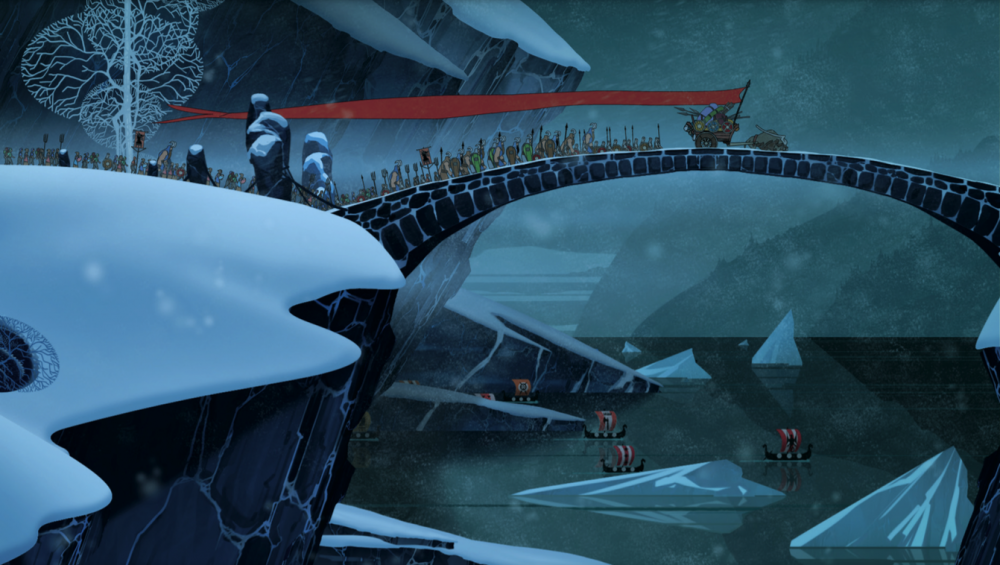By Pankaj Sharma (Contributor) – Email

The Banner Saga series should be near the top of the list when developers and fans make the case for video games as art. Few other titles (such as Shadow of the Colossus and Papers Please) have inspired as much genuine emotion and investment in their story’s outcome. While certainly not perfect, The Banner Saga 2 continues the tradition of achievement from its makers and is a solid installment in the hopefully never-ending series.
The world is ending and the gods are dead. There is perpetual daylight, the sun will no longer set. An ancient enemy, the “Dredge” — a stone-like and mysterious people crafted by a jealous god — have begun pouring out of the earth and overrun most of the land. Even worse, a giant snake is devouring the mountains and the Earth’s crust.
The player takes the role of a desperate caravan of survivors led by the hunter Rook and his daughter Alette as they make their way towards the capital of Abberang. With you travel the last few hundred of the Varl, led by their king of sorts, Hakon. The Varl, a cross between humans and a species known as “yox,” are giants that tower above humans and sport horns and immense strength. While they once held fortresses on the edges of Dredge territory, they have been overrun. Unlike humans, the Varl are all male and cannot reproduce. The rest of the caravan is made up of human clansmen and fighters, the remnant of great cities and villages who have banded together to escape the encroaching end.
The world in Banner Saga is incredibly rich and beautiful, rooted mostly in Norse mythology but also with other original inspirations. The writing is full of depth and the characters are well-rounded compared to typical fantasy narratives. The art direction, animations, and especially sound are incredibly detailed and intricate; the passion of the Stoic team for their work is very evident.
When not in combat, the majority of the game is played through a travel system as you encounter random events and decisions that must be made for the wellbeing of the survivors. At the top of the screen, above your stores of supplies, is a running count of clansmen, fighters, and Varl that follow your banner. Every decision you make (whether to rest, train fighters, accept refugees, or react to the changing landscape around you) affects those numbers. It’s an effective reminder of your responsibility in the game, and many times I found myself dreading having to make a choice, as the consequences for even small decisions can be profound and frightening.
As you progress, Hakon will lament the dwindling number of Varl that follow your banner, and urge you to pick up any survivors you can. However, the bigger your party, the less food there is to go around and the more attention you attract from the Dredge and the apocalyptic, earth-eating snake. I’ve never played Oregon Trail, but many reviewers and fans have likened some of Banner Saga’s mechanics to that game.
The only weakness to the game, aside from its relatively short length, comes by way of the combat mechanics. While the character progression, variety, and skills are very interesting, the fighting is limited in strategy due to how turn order works in the battle system. Each character is assigned armour (how much damage you can deflect) and a strength value (which serves both as your health and how much damage you can deal out), and the option of which value, armour or strength, to target with your attacks. Perhaps to circumvent the common tactic of rushing enemies one at a time, Stoic decided to pace the game so no matter how many enemies there are, the opposing team takes the alternating turn. That means that even if you have taken the Dredge force down to one unit, it will get to act more frequently than your characters. Thus, at higher difficulties, the best tactic to survive more strenuous encounters is to whittle down enemies to low health so they are alive but dealing minimal damage. It’s unique and very interesting, but considering the setting and sense of urgency in the battles it doesn’t feel very fulfilling. I just want to kill things. That’s rewarding.
However, even despite this blemish, the combat is still engaging, offering the player a lot of different strategies and team compositions to explore. Overall this is an amazing game; Stoic Studios might have outdone every other major studio game I’ve played in the past year.


